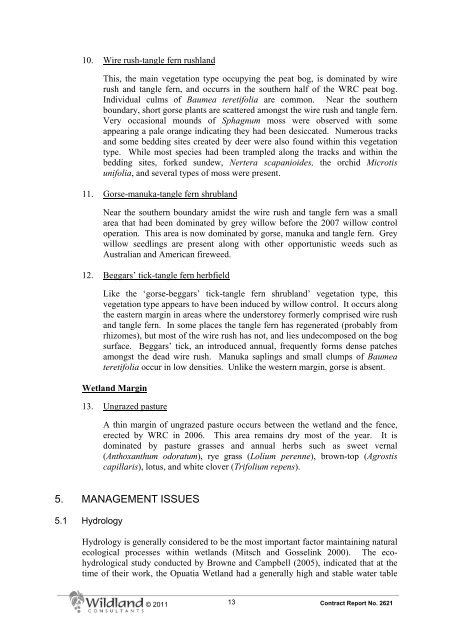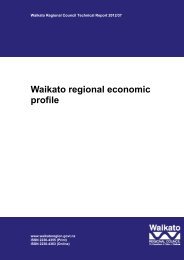Opuatia Peat Bog Management Plan - Waikato Regional Council
Opuatia Peat Bog Management Plan - Waikato Regional Council
Opuatia Peat Bog Management Plan - Waikato Regional Council
Create successful ePaper yourself
Turn your PDF publications into a flip-book with our unique Google optimized e-Paper software.
10. Wire rush-tangle fern rushland<br />
This, the main vegetation type occupying the peat bog, is dominated by wire<br />
rush and tangle fern, and occurrs in the southern half of the WRC peat bog.<br />
Individual culms of Baumea teretifolia are common. Near the southern<br />
boundary, short gorse plants are scattered amongst the wire rush and tangle fern.<br />
Very occasional mounds of Sphagnum moss were observed with some<br />
appearing a pale orange indicating they had been desiccated. Numerous tracks<br />
and some bedding sites created by deer were also found within this vegetation<br />
type. While most species had been trampled along the tracks and within the<br />
bedding sites, forked sundew, Nertera scapanioides, the orchid Microtis<br />
unifolia, and several types of moss were present.<br />
11. Gorse-manuka-tangle fern shrubland<br />
Near the southern boundary amidst the wire rush and tangle fern was a small<br />
area that had been dominated by grey willow before the 2007 willow control<br />
operation. This area is now dominated by gorse, manuka and tangle fern. Grey<br />
willow seedlings are present along with other opportunistic weeds such as<br />
Australian and American fireweed.<br />
12. Beggars’ tick-tangle fern herbfield<br />
Like the ‘gorse-beggars’ tick-tangle fern shrubland’ vegetation type, this<br />
vegetation type appears to have been induced by willow control. It occurs along<br />
the eastern margin in areas where the understorey formerly comprised wire rush<br />
and tangle fern. In some places the tangle fern has regenerated (probably from<br />
rhizomes), but most of the wire rush has not, and lies undecomposed on the bog<br />
surface. Beggars’ tick, an introduced annual, frequently forms dense patches<br />
amongst the dead wire rush. Manuka saplings and small clumps of Baumea<br />
teretifolia occur in low densities. Unlike the western margin, gorse is absent.<br />
Wetland Margin<br />
13. Ungrazed pasture<br />
A thin margin of ungrazed pasture occurs between the wetland and the fence,<br />
erected by WRC in 2006. This area remains dry most of the year. It is<br />
dominated by pasture grasses and annual herbs such as sweet vernal<br />
(Anthoxanthum odoratum), rye grass (Lolium perenne), brown-top (Agrostis<br />
capillaris), lotus, and white clover (Trifolium repens).<br />
5. MANAGEMENT ISSUES<br />
5.1 Hydrology<br />
Hydrology is generally considered to be the most important factor maintaining natural<br />
ecological processes within wetlands (Mitsch and Gosselink 2000). The ecohydrological<br />
study conducted by Browne and Campbell (2005), indicated that at the<br />
time of their work, the <strong>Opuatia</strong> Wetland had a generally high and stable water table<br />
© 2011<br />
13<br />
Contract Report No. 2621

















